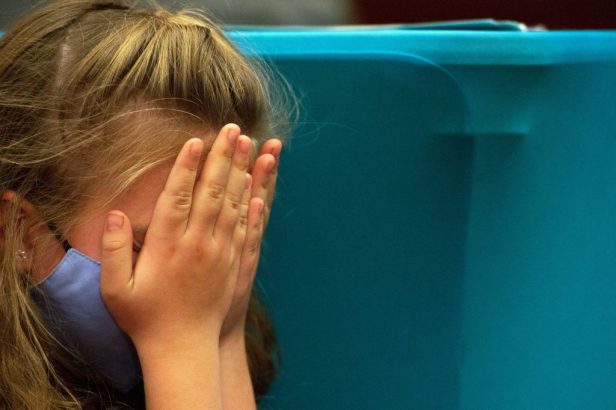With Nearly Half of Parents Expected to Forgo Child COVID Shots, Schools Brace for New Wave of Vaccine Hesitancy

Get stories like these delivered straight to your inbox. Sign up for The 74 Newsletter
This fall in the Elmbrook School District outside Milwaukee, elementary school classrooms come in two flavors: mask-required and mask-recommended. Students in each group, chosen by their parents, rarely interact with one another, except outdoors at recess or in required small-group settings.
“We keep cohorts together during lunch, so if you’re in a mask-required classroom, you’re eating as a group — socially distanced,” said Superintendent Mark Hansen. “We’re keeping those bubbles pretty tight.”
Until now, elementary schoolers couldn’t get a COVID-19 vaccine. No longer. Centers for Disease Control and Prevention Director Dr. Rochelle Walensky on Tuesday endorsed the unanimous vote of a CDC vaccine advisory panel recommending Pfizer-BioNTech’s pediatric coronavirus vaccine for use in children ages 5 to 11. That means as many as 28 million children can begin receiving shots this week.

But just as parents split on masks, they’re also divided on vaccines: Nearly half say they may pass on vaccinating their children for now, mostly because they aren’t especially worried their children will get seriously sick from coronavirus — even as doctors warn the virus will become endemic and virtually unavoidable in coming years, much like the annual flu.
That could set up a tense confrontation in coming months between schools and parents as public health officials push to make the shots part of mandatory school vaccine regimens. And as with the divide over masking, social distancing, and other practices, it could also change how schools operate, as pro-vaccine parents insist on keeping their kids apart from unvaccinated classmates.
Even requiring the vaccine for enrollment might not settle the dispute: An Oct. 23 Morning Consult poll found that 46 percent of parents simply wouldn’t send their child to school if COVID vaccinations are required.
In southern California’s ABC Unified School District near Los Angeles, Superintendent Mary Sieu said many cautious families are already hesitant to send their children back to school — about 700 have remained in remote instruction programs this fall. Overall, she said, the district has lost more than 1,400 students over the past two years, forcing her to consider closing one of her schools next year.
“I just feel that a lot of people are afraid of coming back to school,” she said.
While recent research suggests that children remain at a lower risk than most adults of contracting serious illness due to the virus, outbreaks happen. In one survey, conducted in early October, nearly one in three parents said their child’s schooling had been disrupted by COVID-19.
“Look at your ZIP code and see what your vaccination rates are, and your infection rates are,” said Daniel Domenech, executive director of the American Association of School Administrators. “That’s going to tell you the quality of education that those kids are getting in those schools. If a child isn’t in school consistently, they’re not going to be getting the quality education that they need. That’s the bottom line.”
Domenech, a former superintendent in Fairfax County, Va., said he fears that the vaccination gap taking shape between districts could replicate the existing achievement gap. Recent research in California has found, for instance, that communities with high poverty rates had COVID-19 infection rates in 2020 that were two to three times as high as those in wealthier areas.
“What we’ve seen is that the areas that are suffering the most in terms of lack of a vaccine and high infection rates are exactly [high-poverty] areas, where families of color are afraid to get their kids vaccinated and are afraid to send their kids to school,” Domenech said.
‘Ripe for a contentious situation’
Though they typically get a raft of vaccinations just to attend school, children’s COVID-19 vaccination rates have already shown evidence of parental hesitation. In September, the CDC said just 42 percent of children ages 12 to 17 had gotten at least one shot and 32 percent had completed the two-shot dose by July 31. That’s more than two months after the FDA granted it emergency use authorization — and more than seven months after it first approved the vaccine for adolescents aged 16 to 17.
In Marshalltown Community School District, northeast of Des Moines, Iowa, as many as 90 percent of school employees are vaccinated, said Superintendent Theron Schutte. But just 40 to 50 percent of eligible students have been vaccinated so far. For the youngest eligible students, ages 12 to 13, the vaccination rate is closer to 40 percent. “My guess is that a lesser percentage of the younger kids’ parents will probably get them vaccinated,” he said. “I’m hoping that more of them do.”
Dr. William Raszka, a professor of pediatrics at the University of Vermont’s Larner College of Medicine, said the risk-benefit analysis for vaccination “is just so overwhelming. I have trouble understanding why someone wouldn’t get vaccinated at this point in time.”
So far, he said, life-threatening illnesses associated with the vaccines “are awfully rare.” One of the most common reactions to Pfizer’s vaccine — the only one approved for emergency use in children — is “a sore arm,” he said.
From the beginning of the pandemic, said Schutte, “We operated on the premise that we know COVID’s going to come into the school. There’s no way we can know whether it is or isn’t coming in – but what we can control is its opportunity to spread.”
He couldn’t immediately predict how his school board would respond to the recent FDA approval of childhood COVID vaccines. “They’re a reflection of our community. So if our community is split on whether we should or shouldn’t require vaccinations, I think it’s always going to be ripe for a contentious situation.”
Mandates are years off
Once COVID vaccines earn full FDA approval, states could move quickly to mandate them for school attendance — California Gov. Gavin Newsom has already said he plans to add it to the list of vaccinations required to attend school in-person for middle and high school grades, as with vaccines for measles, mumps, rubella, and the like. “We want our kids back in school without episodic closures,” Newsom said on Oct. 27.
Speaking after he received a COVID booster shot in Oakland, Newsom said children already receive 10 other vaccinations in order to attend school. “The politics around this are disturbing to me. Lives are quite literally at risk.”

Leaders in four of the state’s largest school districts — Los Angeles, Sacramento, San Diego and Oakland — have already said students must get a first shot of the vaccine or attend school virtually from home in January.
But former FDA commissioner Dr. Scott Gottlieb in October predicted that any COVID vaccination mandate for school attendance would be “a couple of years away, perhaps a little longer,” for children ages 12 to 17, and even further for children ages 5 to 11. Appearing on CBS’s Face the Nation, Gottlieb said CDC has typically taken several years to add most childhood vaccines to their immunization schedule.
That will leave the decision for now to parents like Debra Garrett, a mother of four children, all of them under 12, in Troy, N.Y.
Garrett said she’s vaccinated, but added, “I’m not really sure about my kids getting it done right now.” Parents need more information about how the vaccines affect children, she said. “It’s all brand new. We don’t know how anybody’s going to respond to it.”
That sensitivity is heightened, Garrett said, because she grew up Black in a country with a history of mistreating Black research subjects in the name of medicine. “I just don’t want my child to be looked at as ‘the tester,’” she said.

Garrett’s four children all attend Troy Prep, part of the Uncommon Schools network of charter schools in six Northeastern cities. She said the school has given parents of students 12 and up the choice to vaccinate.
But if Uncommon makes vaccination mandatory, “that’s when it’s going to be tricky — and it’s going to get tough for the school, and for parents. I just feel like there is going to be some kind of push and pull on both ends. I can’t say whether one is right or wrong, but what I do know for certain is that we have to educate people in order for them to be able to fully get it and fully feel like, ‘They’re not just pricking my kid.’”
Many parents will likely find themselves agreeing with Garrett. In a June Education Next survey , as the more-contagious Delta variant began to take hold in the U.S., the parents of just 51 percent of students under age 18 said they’d “probably” or “definitely” have their child vaccinated, with vaccine hesitancy much higher for parents of younger children. They’re far less likely to say they’ll vaccinate their kids compared to parents of high schoolers — 46 percent vs. 59 percent.
Political party affiliation also plays a role: Republican-identifying parents of 35 percent of children say they’ll vaccinate their kids, while that figure is much higher for Democrats at 66 percent.
A September Gallup poll suggests that just 55 percent of parents of children under 12 would get them an available vaccine. Parents’ own vaccination status strongly predicted their attitude toward their kids: 82 percent of parents who were fully vaccinated against COVID-19 said they’d vaccinate their child, while just 1 percent who don’t plan to get vaccinated themselves planned to vaccinate their kids.
Dr. Benjamin Lee, a pediatric infectious disease specialist and associate professor at the University of Vermont Children’s Hospital, said the findings are cause for concern.

“It’s discouraging to me to see how many parents have already sort of expressed that they don’t want to get their children vaccinated as soon as vaccines are available,” he said.
While it’s natural for parents to hold out a high threshold for vaccine safety, he said, no vaccine carries zero risk. “And that includes all of the vaccines that we use routinely” for both children and adults. “In all scenarios, the data are so overwhelming that risks from vaccination are far lower than the risks of natural infection.”
Schutte, the Iowa superintendent, said it’s true that children are less likely than adults to get seriously ill due to COVID, but he urged parents to see the bigger picture: Even if kids don’t get sick, they could take the virus home. “We have a lot of multi-generation (families) living under the same roof in our community,” he said. “So it’s not only the parents, but the grandparents, and maybe in some cases, the great-grandparents.”
The longer it takes to get most people vaccinated, he said, “the longer the situation is going to stretch out.”
In reality, said Lee, the Vermont pediatrician, SARS-CoV-2 “is going to be with us from now on. Any chance to completely eradicate this virus is long gone. And this will become an endemic virus,” like the annual flu, sticking around for years. Because it’s so contagious, he said, “what we should recognize is that all of us are going to get this virus. And the question is: Under what conditions or terms do we want to catch it?”
So far, the only statistically significant side effect of the vaccine is a mild case of myocarditis, or inflammation of the heart muscle, in adolescent males. But it’s enough to prompt physicians in a few countries to give young people just one dose of the Pfizer-BioNTech vaccine, offering at least partial protection from the virus without this side effect.
“We should acknowledge that that is a known risk of vaccination,” Lee said. “However, when you look at the risk of myocarditis from vaccine versus the risk of myocarditis from COVID-19, the risks are far higher of catching myocarditis if you catch COVID-19 than from the vaccine itself.”
Also, he noted, “almost without exception” the myocarditis associated with the vaccine is “a very, very mild illness that completely resolves.” COVID-19, by contrast, carries a higher risk of severe outcomes.
Lee also warned against taking to heart the many unsupported claims about the vaccines’ quick development and emergency approval, claims that might turn parents, like Garrett, off to vaccination. “When all is said and done, these will end up being the most heavily scrutinized vaccines in terms of safety perhaps ever, compared to any vaccine that we’ve ever used.”
Get stories like these delivered straight to your inbox. Sign up for The 74 Newsletter

;)
